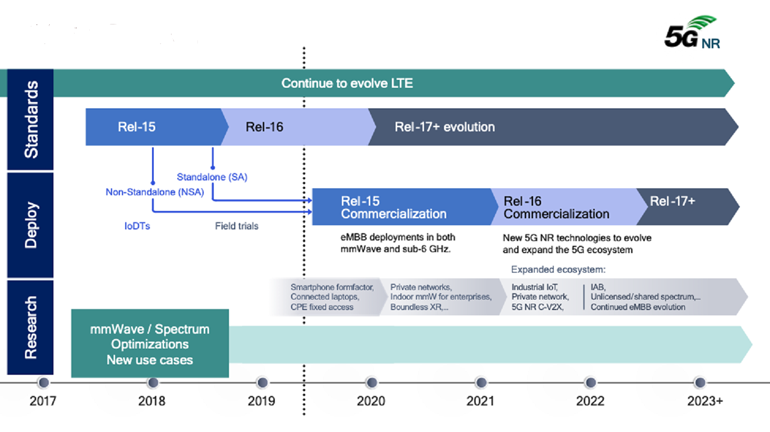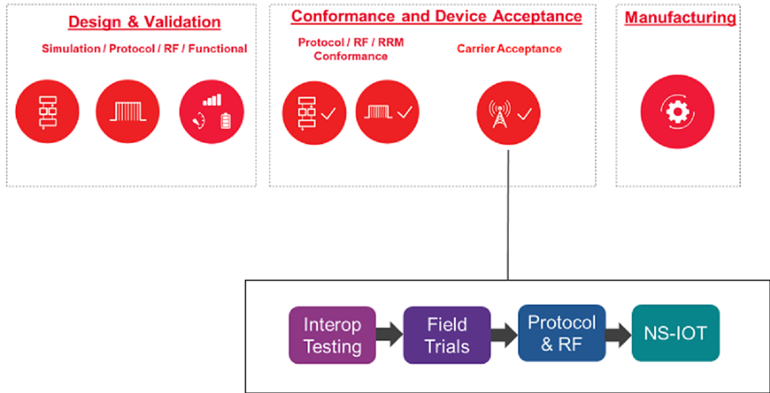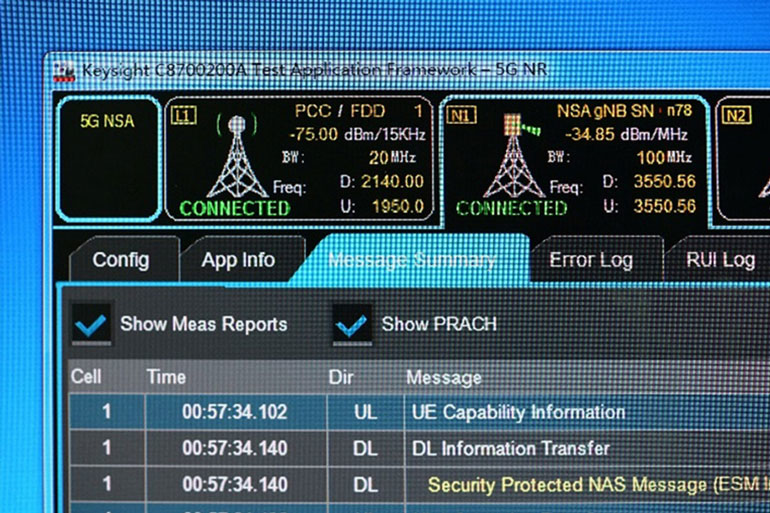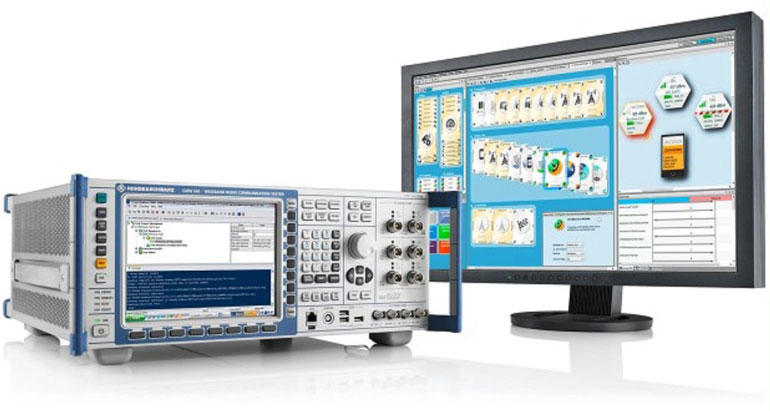People demand the best in performance when it comes to wireless technology. New 5G advancements allow speeds up to 100 times faster than existing cellular connections and latency in the 1-millisecond range, 5G will even surpass the current capabilities of physical fiber optics.
5G technology is driving major changes across the entire network — from highly flexible radio access network (RAN) architecture and 3D beamforming active antennas to software-defined network components — with stringent timing and latency requirements.
The combination of new infrastructure features and functions, such as millimeter wave (mmWave) utilization and massive MIMO, provides a pathway to incredible performance enhancements. Yet these expected enhancements will rely on multiple elements performing seamlessly in tandem, introducing much greater complexity than previous generations. Mission-critical applications will demand a network that cannot fail.
To support a successful transition, 5G test practices are being developed and refined to ensure the consistent 5G performance that end users demand. The collective tools, software, protocols, and practices required for all 5G deployment phases form the core of the emerging 5G testing field.
5G testing means more than verifying the lightning-fast download speeds, super-low latency, and expansive coverage density. Ensuring network quality will be at the core of deployment to prevent dissatisfied end users, churn, and loss of market share.
Simplified, end-to-end 5G test solutions are playing a vital role in the development, deployment, and operational excellence of emerging 5G networks. 5G testing has become a critical enabler of 5G potential. Test solutions have quickly adapted to complex use cases and wholesale architectural advancements encompassing core, transport, RAN and fiber network elements simultaneously. This has necessitated advanced emulation and verification technology in the 5G test lab that is scalable to full 5G deployment in the field.
5G test challenges
The earliest 5G deployments were based on non-stand-alone (NSA) configurations, where existing 4G infrastructure is used, although radios will be capable of providing services to 5G-capable devices as they are introduced. The initial 5G New Radio (NR) specification was completed in June 2018 and published in the 3GPP Release 15 specification. Now, a variety of industry players, including network equipment vendors, network operators, semiconductor vendors, and device manufacturers, are developing new products that implement the new standard.
The 5G test and conformance era are far more challenging than 4G wireless amid a broad range of new services and technology paradigms. There’s a large matrix of test cases that vary widely, and these changes reinforce the importance of adequately validating the device performance on 5G networks as specified in the New Radio (NR) standard.
In this initial phase of 5G deployment, the focus is on enhanced mobile broadband (eMBB) service to provide increased data bandwidth and connection reliability. Unlike in LTE networks, 5G new radio (NR) will support higher frequency operation from day one. Frequency range one (FR1) overlaps and extends 4G LTE frequencies, operating from 450 MHz to 6 GHz, whereas frequency range two (FR2) operates at a much higher frequency range and will support up to 52.6 GHz.
Another critical issue in 5G device radio performance testing and validation is the diverse deployment of radio spectrums. For now, 28 GHz and 39 GHz 5G millimeter wave bands are the most popular, but eventually 5G networks could employ mmWave frequencies ranging from 26.5 GHz to 67 GHz. Therefore, the test solution must provide far field radio characterization capabilities — gain, directivity, beamwidth, 3D radiation pattern and antenna efficiency — across a broad range of mmWave frequencies.
Businesses working in the consumer market must test new 5G modems, antennas, subsystems, and fully assembled 5G devices, such as smart technology and smartphones. Companies working with telcos or similar clients may need to develop testing workflows for base stations. The most significant changes for the testing industry will be using millimeter-wave (mmWave) technology, beamforming, and arrays of antennas that leverage multiple-input multiple-output (MIMO).
5G technology has a lot in common with its predecessor, but key differences between the two standards will require the testing industry to develop a new approach. For example, 5G equipment—like all telecommunications equipment—will need to be protected from EMI and tested for EMC. Higher power requirements and frequency bands used by the technology compared to 4G, however, increase the threat of EMI and change how networking hardware may be vulnerable to interference.
The field trials for 5G mmWave radios have already started generating and analyzing frequency bands of up to 40 GHz. And what has been discovered here is that measuring the parameters, like signal profile, range and capacity for higher-gain antennas steering more powerful beam signals in mmWave communications, is far more challenging than LTE testing.
Also, the components designed for mmWave devices are compact and highly integrated with no place to probe, resulting in the need for radiated tests, also known as over-the-air (OTA) tests.
As such, standards compliance takes on an increasingly crucial role to ensure functionality and interoperability. Likewise, standards are key to developing accurate 5G test models, leading to more harmonized test practices and empowering faster 5G network development and deployment. Service providers and NEMs need to understand and embrace standards-compliant testing methods to ensure the smoothest path forward for 5G innovation.
The added complexity introduced by new 5G functionality is posing challenges for network equipment manufacturers (NEMs) and communication services providers (CSPs) alike. Moreover, these complications are further compounded by the adoption of disaggregated architectures in which integrated hardware and software are separated and broken down into functional components.
As CSPs seek to improve service agility and lower costs, they are increasingly moving away from proprietary network equipment, instead using common off-the-shelf components. This raises the stakes for interoperability and performance, since no single vendor is responsible for validating and verifying the entire system.

Just as we saw with previous generations, 5G networks will evolve across multiple 3GPP releases. Therefore, it’s vital to have a controllable and repeatable test environment that helps implement the latest standards and simplifies the 5G development life cycle, in order to ensure that network equipment deployed in the field is protected and customer experience is not compromised.
5G Certification
Conforming to Norms
3GPP is the body that has set the standards by which equipment is both designed and tested in order to meet those standards. OEMs, chipset and software component vendors, test houses and network operators all make use of 3GPP conformance testing, in addition to other tests such as carrier acceptance testing — which requires that a device meet an additional set of conditions set by the mobile carriers themselves before they will allow it to be sold and operate on their networks.
Conformance tests are important for developing a baseline of functionality in user equipment (UEs) and base stations, as well as validating transmitter and receiver characteristics and performance. Radio resource management (RMM) and protocol testing are needed for devices, while radio frequency (RF) parameters are used as a baseline to test base stations.
5G UE certification
3GPP conformance testing is actually a specific group of tests that involve connecting wireless device to a system of wireless test equipment, and then performing specific tests that are mandated by 3GPP. Some of them involve the radio frequencies on which the device operates, some of them are protocol-based tests; some of them are conducted over-the-air, and there may also be testing of device SIM cards. The Global Certification Forum, one of two major organizations for the 3GPP-based device certification, also requires that the device be drive-tested. The pass-fail limits for 3GPP conformance testing are one of the test determinations made by 3GPP in the course of developing the tests. “Without passing these tests, you can’t take your phone to market and sell it,” said Mike Barrick, business development manager for wireless at test company Anritsu. He noted that protocol and RF tests are the main focuses of the 3GPP conformance testing, however.
A number of other standards bodies also are contributing significantly in this area. The International Telecommunications Union (ITU) and the International Mobile Telecommunications (IMT) group created IMT-2020, which has 3 primary use cases for 5G NR: eMBB; ultra-reliable low latency communications (URLLC); and massive machine-type communications (mMTC).
The 5G conformance test spans RF characteristics, radio resource management (RRM), and communication protocol suites, and that calls for flexible test solutions that can eventually be customized for specific use cases and certification requirements. At the same time, it’s also critical that both chipsets and devices are rigorously tested under linear and nonlinear conditions across the entire workflow, from design validation to product manufacturing. 5G conformance testing encompasses two technology realms: sub-6-GHz bands with new multiple-input multiple-output (MIMO) antenna systems and higher-frequency millimeter-wave (mmWave) bands with highly focused beamsteering. The conformance testing matrix further expands with different spectrums operating across the globe and the need for 5G devices to work in both non-standalone and standalone modes.
That calls for engineers to thoroughly test the parametric performance, physical-layer (PHY) characteristics, and protocol functionality of the device’s chipset using the same emulated network and communication channels employed by 5G carriers. The following section provides highlights of the extended matrix of 5G test cases that includes functional testing, negative testing, regression testing, KPI testing, data-throughput testing, and overall device performance testing.

Meanwhile, conformance testing for UEs depends upon radio access, demodulation and signaling tests, as well as validation by certification organizations to ensure they comply to the latest 3GPP specifications. Yet, the 3GPP RAN working committee defines the conformance goals, which are not yet complete for 5G NR.
There are other pressures as well when it comes to accelerating the conformance to advance 5G commercialization. For instance, network operators, as well as chipset and device manufacturers, are striving to ensure successful device testing and acceptance on the first attempt. But that’s easier said than done.
5G Conformance Matrix
The conformance test requirements, as specified in the 3GPP 5G NR standard, include a wide range of RF demodulation and RRM test cases. And they can be validated by the Global Certification Forum (GCF) and PCS Type Certification Review Board (PTCRB), a certification platform comprised of the leading U.S. mobile operators.
Start with the Testing and Test Control Notation version 3 (TTCN-3) conformance testbed, a core language that 3GPP uses to specify different types of reactive system tests over a variety of communication ports. The TTCN-3 conformance use cases employ real user equipment (UE) and real hardware in the form of network simulators to verify 5G designs.
Next, RAN5, a workgroup within 3GPP, focuses on the conformance testing specification for the radio interface of UE devices. It’s organized in the RF subgroup and the signaling subgroup, respectively, and it encompasses both RF and RRM conformance tests. The RAN5 workgroup approves the Protocol Conformance Tests as defined in the 3GPP TS38.523 requirements.
The 5G conformance testing ranges from device R&D and design validation to conformance verification to carrier acceptance and manufacturing. Thus, the 5G mobile ecosystem is being streamlined from early prototyping to design validation to device manufacturing. Take, for example, the Chinese phone maker Oppo, which unveiled the 5G handset “Reno” in April 2019. It demonstrated the world’s first 5G signaling and data connection for a video call in November 2018.
According to James Kimery, director of wireless research at National Instruments (NI), assessing the performance of video and data delivery is crucial for 5G devices. It’s worth mentioning here that 5G device manufacturers like Oppo are employing the same tools that chipmakers use to validate 5G NR designs. Moreover, protocol conformance tests for both chipsets and devices are a key enabler in validating the performance of 5G designs. And they mandate the availability of complete protocol stacks on a software platform with fully developed, carrier-based test cases. Below is a sneak peek into various conformance test cases that demonstrate how chipset and device manufacturers are validating the 5G NR designs across the entire workflow.

Performing Above and Beyond
Deploying and supporting complex 5G network architecture will not be a trivial exercise. 5G NR will introduce flexible spectrum usage with scalable numerology, dynamic TDD, massive MIMO and beamforming — all of which will introduce greater challenges in the field for RF engineers to validate, test, and optimize the 5G network. Time-to-market and network quality will be largely dependent on the rigor of test and measurement before, during, and after, deployment.
A key factor to consider when testing 5G is how to assure quality of experience (QoE) for the end user. Unlike with previous generations, however, this requires the understanding that in many cases, the end user on 5G networks will be machines, rather than humans. This means that current methodologies for testing and measuring voice, video, and data, quality to end users need to be expanded to include mMTC and artificial intelligence (AI).
The 3 primary use cases identified by IMT-2020 (eMBB, URLLC, and mMTC) also drive the need for different ways to measure QoE, especially in the RAN. Expanded test methodologies are needed that include new parameters that incorporate higher frequencies and wider bandwidths, accounting for machine-to-machine communications.
As 5G networks grow to support applications like connected cars, network performance will become absolutely crucial. Delay, jitter, and other network issues, can literally have disastrous results, so testing of 5G QoE needs to be verifiably traced and transparent to certified international standards bodies, as opposed to proprietary NEM specifications or techniques.
5G Conformance Test Cases
Samsung’s Exynos Modem 5100, compatible with 3GPP Release 15, supports both sub-6-GHz and mmWave spectrums with a single-chip solution. The company has conducted an over-the-air (OTA) 5G NR data call test under a wireless environment utilizing a 5G base station and 5G end-user equipment prototype embedded with the Exynos Modem 5100. “5G wireless is evolving much faster than previous cellular technologies,” said Woonhaing Hur, vice president of System LSI Protocol Development at Samsung Electronics. “Especially after 3GPP officially approved the first round of 5G specifications in the summer of 2018.”
Marvin Test Solutions has developed a manufacturing test platform for beamforming ICs under linear and nonlinear conditions. Beamforming IC testing is crucial in 5G mmWave systems, utilizing component- and system-level simulation tools to facilitate high-precision measurements at mmWave bands. “The test systems need to be ready for a new class of 5G beamforming devices,” said Alastair Upton, chief strategy officer at Anokiwave. The company offers mmWave ICs for active antenna arrays and has demonstrated OTA validation of antenna-in-package (AiP) devices in collaboration with National Instruments (NI). The OTA-based RF validation significantly shortens development schedules and helps test professionals achieve faster speeds compared to traditional point-by-point software-controlled test systems
Given the enormous frequency range and high-bandwidth services inherent to 5G technology, standardization of best practices will continue to progress as the technology, tools, and applications, develop.

“The 5G NR systems demand modular hardware and software platforms that address the testing needs of today and well into the decade,” said Mike Thorpe, product manager at Rohde & Schwarz. The test-and-measurement company is working with quality-assurance specialist Intertek and conformance test labs to test the signaling, RF parameters, and data-throughput rates of simultaneous LTE/5G links in dual-connectivity mode.
As the above test cases show, the 5G conformance initiatives are starting to accelerate after the early rollout of 5G NR networks in 2019. And these activities are likely to gather pace in 2020 and beyond when 5G reaches the cusp of commercial deployment.
Test and Measurement Market
The Global 5G Testing Equipment Market size was estimated at USD 1,312.77 million in 2021, USD 1,651.38 million in 2022, and is projected to grow at a Compound Annual Growth Rate (CAGR) of 25.97% to reach USD 5,245.65 million by 2027.
The global 5G testing equipment and solutions market is expected to reach $2 billion by 2024 with a compound annual growth rate of 11.5%, according to a new forecast from analyst firm Frost & Sullivan. The firm said that it expects that “healthy double-digit growth rate” over the next four years, even though growth in some 5G test segments “will appear sluggish because, initially, the 5G network that is deployed commercially will not have full functionality”—i.e., the deployment of Nonstandalone 5G first, followed by an evolution to Standalone mode and full 5G capabilities.
“5G has just broken ground, with limited deployments across South Korea, other countries across the Asia-Pacific, and North America,” said Rohan Joy Thomas, industry analyst for Measurement and Instrumentation at Frost & Sullivan. Thomas pointed out that the various technologies which 5G is expected to support—such as enhanced mobile broadband and massive internet of things deployments—will drive the need for differing test capabilities.
“As new functionalities that enable IoT use cases are added upon 5G, it will influence the demand for testing equipment used to test those specific IoT functionalities,” he said, adding that on the wireline side, “The push for greater bandwidth will require enhanced fiber-optic technology, thereby driving demand for fiber-optic testing equipment. As 5G continues to gain strength, the need for testing solutions that can validate the performance of the high-density data will also increase.”
Frost & Sullivan forecasted that by 2024, 42.8% of the total 5G test market revenue will come from the Asia-Pacific region, followed by 33.8% of revenue coming from North America and 18.1% generated in Europe.
Some key players include Anritsu Corporation, Artiza Networks, AT&T, EMITE Ingenieria S.L., EXFO, Infosys,
Intertek Group PLC, Keysight Technologies, KT Corporation, MACOM Technology Solutions, McGrath RentCorp,
National Instruments, NTT DOCOMO, Rohde & Schwarz GmbH & Co KG, Sequans Communications SA, Siklu Communication, Spirent Communications, TEKTRONIX, Telefonaktiebolaget LM Ericsson, Teradyne, and VIAVI Solutions
The Case for Unified Test Platforms
The race to 5G commercialization is on, currently led by customer-premises-equipment (CPE) units for the fixed wireless access service, which is promising to offer multi-gigabit wireless throughput in select U.S. cities. Furthermore, mobile hotspots and 5G smartphones are being launched around the world. It all begins with demonstrating stability and high data rates in clean and ideal channel conditions. The toolsets allow test engineers to emulate the real-world complexities related to 3D fading and channel interference conditions inside the lab environments.
Once test professionals have done that, they must validate the mobile-device or base-station performance under real-world conditions, where the channel is non-ideal, complex, faded, and filled with interference. So, 5G test professionals require reliable tools to characterize the system performance of mobile devices and base stations across all 5G NR signal bandwidths. The latest initiatives and developments regarding 5G conformance, as well as the recent test cases outlined in this article, also call for a holistic approach. That’s because a unified system can efficiently handle the RF, IF, and mmWave frequencies in the most realistic replication of a real-world environment.
Rohde & Schwarz introduced a new Wi-Fi 6 (802.11ax) test solution that it says allows both Wi-Fi accss points and WLAN stations to be tested in either single-input single-output mode or multiple-input multiple-output mode, and in single-user or multi-user operation. The WLAN 11ax signalling test option with the R&S CMW270 Wireless Connectivity Tester support FODMA precorrection tests that Rohde & Schwarz says are in line with Wi-Fi Alliance certification for Wi-Fi 6. R&S also noted that it developed a WLAN protocol stack, which in conjunction with individual process sequences means that users can carry out the complex testing associated with 802.11ax rapidly and with only a single instrument.
Wi-Fi 6 brings orthogonal frequency-division multiple access (OFDMA) technology to Wi-Fi, for multi-user support via sharing available bandwidth. Rohde said that OFDMA “presents new challenges for developers of WLAN devices and significantly expands the scope of testing for the certification of Wi-Fi 6 devices.”
Rohde & Schwarz also launched a compact test solution aimed primarily at 5G production testing of devices and components in millimeter wave frequencies, the R&S CMPQ. It also put out a new 5G site testing bundle, which consists of its R&S TSMA6 autonomous receiver to show all LTE and 5G signals, a downconverter, a QualiPoc Android smartphone-based handheld network troubleshooter, and the R&S Cable Rider ZPH analyzer.
The TSMA6 receiver identifies channel frequency and provides signal quality analysis, while the QualiPoc smartphone solution checks out cell and beam quality measurements and can verify the presence and quality of the LTE anchor cell for NonStandalone 5G implementations. (Recent testing by Signals Research Group illustrated just how important strong LTE is to 5G NSA coverage; read that story here.) More details on the gNodeB test bundle here.
Keysight Technologies has announced a collaboration with security vendor Riscure to step up security for a highly connected 5G world. The two companies said that the partnership, which will combining Keysight’s testing and visibility solutions with Riscure’s suite of security test tools, aims to “advance the development of secure and resilient 5G networks, devices and services.” In particular, Keysight said, the combination will rely on its 5G emulation capabilities, so that customers can better assess their risks and figure out how to protect their 5G assets.
“A combination of Riscure’s expertise in securing software, chip technology and connected devices with Keysight’s comprehensive portfolio of test and visibility solutions, allows our customers to deliver robust, functional and secure solutions for a global 5G security market that is projected to reach more than $4B in 2023,” said Marc Witteman, CEO at Riscure, in a statement. “Working together with Keysight, we will contribute years of security experience to help build one of the most important technology domains—the future of mobile connectivity.”
References and Resources also include:
 International Defense Security & Technology Your trusted Source for News, Research and Analysis
International Defense Security & Technology Your trusted Source for News, Research and Analysis
